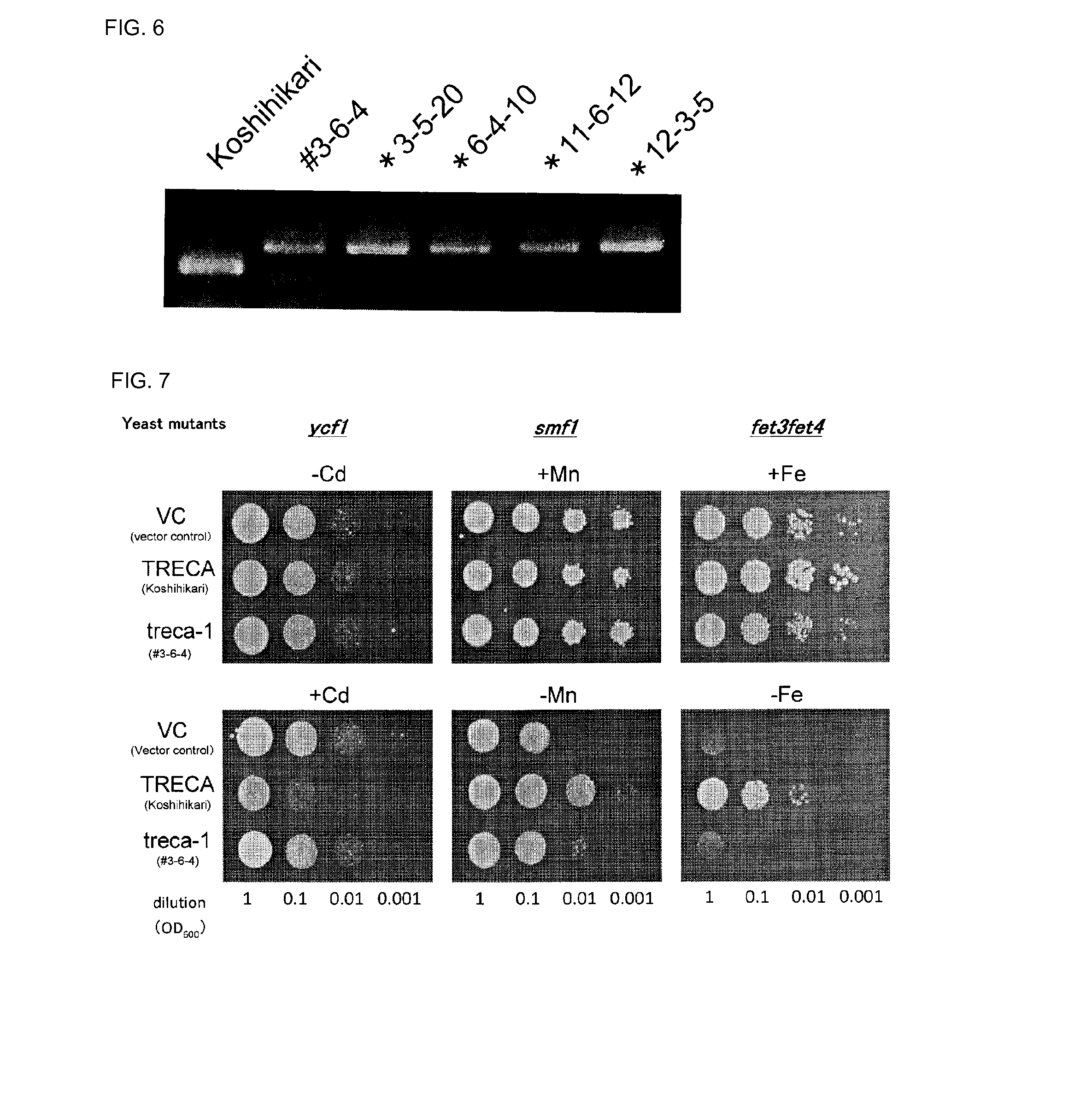Cadmium absorption regulatory gene, protein and cadmium absorption-inhibiting rice plant
a cadmium absorption and regulatory gene technology, applied in the field of mutant transporters, can solve the problems of many years, costs, effects, and limitations of conventional methods, and achieve the effect low cd absorption, and efficient selection of low cd absorption
- Summary
- Abstract
- Description
- Claims
- Application Information
AI Technical Summary
Benefits of technology
Problems solved by technology
Method used
Image
Examples
example 1
Selection of Rice Mutants with Reduced Cd Absorption
[0070](Irradiation of a Heavy Ion Beam)
[0071]Using TIARA of Takasaki Advanced Radiation Research Institute, Japan Atomic Energy Agency, 3500 grains of rice plant (Koshihikari cultivar) seeds (the present seeds are first generation seeds, hereinafter abbreviated as M1, and the second, third generation and the like are referred to as M2, M3 and the like) to which a heavy ion beam (carbon ion, 320 MeV, 40 Gy) was applied were seeded in compost (manufactured by Sumitomo Chemical Co., Ltd., Product Name: Bonsoru 1). The obtained seedlings were transplanted as each individual in a paddy farm field possessed by National Institute for Agro-Environmental Sciences and M2 seeds were obtained from each individual by conventional cultivation management in National Institute for Agro-Environmental Sciences. The obtained M2 seeds, approximately 100,000 grains, all were mixed and used for the following selection step of low Cd mutants.
[0072](First...
example 2
Confirmation of the Low Cd Trait of Mutants
[0082](Evaluation in Hydroponic Cultivation)
[0083]The seeds of M3 lines of low Cd mutants (#3-6-4, #7-3-6, #7-2-13) selected using the Cd concentration in brown rice as an index and Koshihikari untreated with a heavy ion beam (hereinafter, simply referred to as Koshihikari) were seeded and the seedlings after a lapse of 10 days as with Example 1 were treated with Cd by a hydroponic method. After a lapse of 4 days from Cd treatment, harvesting was carried out, and the harvest was separated into shoots and roots, followed by drying. The dry samples were digested with a strong acid by the same method as for the brown rice in Example 3. In addition to Cd, manganese (Mn), copper (Cu), iron (Fe) and zinc (Zn), essential elements for plants, were contained in the decomposition liquid and all of the elements were simultaneously measured by an inductively coupled plasma optical emission spectrometer (ICP-OES) (manufactured by Agilent Technologies, P...
example 3
[0090](Microarray Experiments)
[0091]RNA was extracted from roots of the above mutant (#3-6-4) and Koshihikari according to the protocol of an RNA purification kit (manufactured by Rizo Inc., Product Name: RNAs-ici!-S). The RNA concentration was measured by a spectrophotometer (manufactured by Thermo Fisher Scientific, Product Name: NanoDrop 1000) and the quality was checked by Agilent 2100 Bioanalyzer to confirm whether or not the extracted RNA was degraded.
[0092]The extracted total RNA (400 ng) was reversely transcribed using T7 promoter primer (Agilent) to synthesize cDNA. For fluorescence labeling, Cyanine 3 (hereinafter, referred to as Cy3) and Cyanine 5 (hereinafter, referred to as Cy5) were added thereto and a labeled cRNA was synthesized by reaction in Transcription Mix solution with T7 RNA polymerase (Agilent).
[0093]The labeled cRNA extracted and synthesized from each individual described above was purified by Qiagen RNeasy Kit (manufactured by Qiagen) and th...
PUM
| Property | Measurement | Unit |
|---|---|---|
| concentration | aaaaa | aaaaa |
Abstract
Description
Claims
Application Information
 Login to View More
Login to View More - R&D
- Intellectual Property
- Life Sciences
- Materials
- Tech Scout
- Unparalleled Data Quality
- Higher Quality Content
- 60% Fewer Hallucinations
Browse by: Latest US Patents, China's latest patents, Technical Efficacy Thesaurus, Application Domain, Technology Topic, Popular Technical Reports.
© 2025 PatSnap. All rights reserved.Legal|Privacy policy|Modern Slavery Act Transparency Statement|Sitemap|About US| Contact US: help@patsnap.com



